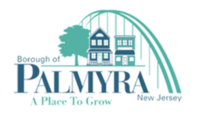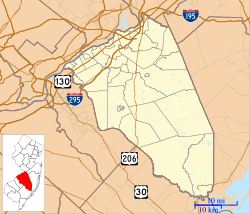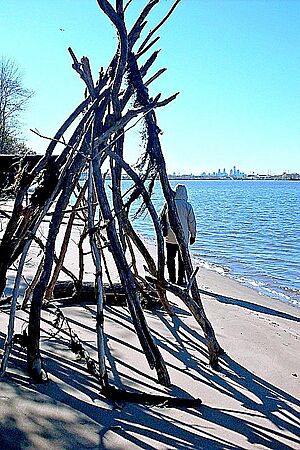Palmyra, New Jersey facts for kids
Quick facts for kids
Palmyra, New Jersey
|
||
|---|---|---|
|
Borough
|
||
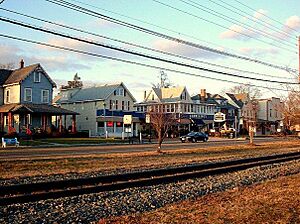
East Broad Street near northern edge of the borough with River Line tracks in foreground
|
||
|
||
| Motto(s):
"A Place to Grow"
|
||

Location of Palmyra in Burlington County highlighted in red (right). Inset map: Location of Burlington County in New Jersey highlighted in red (lower left).
|
||
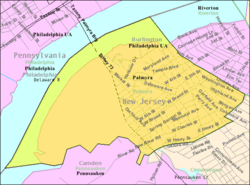
Census Bureau map of Palmyra, New Jersey
|
||
| Country | ||
| State | ||
| County | Burlington | |
| Incorporated | April 19, 1894 | |
| Named for | Palmyra, Syria | |
| Government | ||
| • Type | Borough | |
| • Body | Borough Council | |
| Area | ||
| • Total | 2.54 sq mi (6.58 km2) | |
| • Land | 1.85 sq mi (4.79 km2) | |
| • Water | 0.69 sq mi (1.79 km2) 27.28% | |
| Area rank | 371st of 565 in state 32nd of 40 in county |
|
| Elevation | 7 ft (2 m) | |
| Population
(2020)
|
||
| • Total | 7,438 | |
| • Estimate
(2023)
|
7,489 | |
| • Rank | 308th of 565 in state 23rd of 40 in county |
|
| • Density | 4,022.7/sq mi (1,553.2/km2) | |
| • Density rank | 157th of 565 in state 7th of 40 in county |
|
| Time zone | UTC−05:00 (Eastern (EST)) | |
| • Summer (DST) | UTC−04:00 (Eastern (EDT)) | |
| ZIP Code |
08065
|
|
| Area code(s) | 856 exchanges: 303, 726, 829, 786 | |
| FIPS code | 3400555800 | |
| GNIS feature ID | 0885339 | |
| Website | ||
Palmyra is a small town, called a borough, located in Burlington County, New Jersey. In 2020, about 7,438 people lived here. Palmyra is part of a larger area that includes the cities of Philadelphia, Reading, and Camden.
Palmyra became an official township on April 19, 1894. It was formed from parts of Cinnaminson Township and Riverton. Later, on February 20, 1923, Palmyra changed its status to a borough.
Contents
History of Palmyra
Early Settlers and Name Change
The area that is now Palmyra was first settled in the late 1600s by people from Sweden. This marked the northern edge of a place called New Sweden. A farmhouse built in 1761 by these early settlers is still the oldest house in Palmyra today.
For a long time, farming was the main activity in Palmyra. This changed after the Camden and Amboy Railroad was built in 1834. The railroad added a station in the area. Soon, railroad workers started buying land and building homes along the tracks.
The community was first known as Texas. But a local landowner named Isaiah Toy wanted a post office there. He was a big fan of ancient history. In 1849, he convinced the railroad to change the station's name to Palmyra. This name came from an ancient trading city in Syria. The post office officially opened in 1851.
Town Development
In 1850, the town was planned out. Joseph Souder's land was divided into building lots. The streets were named after streets in Center City, Philadelphia, like Market, Arch, Race, and Vine. The streets running from the Delaware River were named Front Street and numbered streets.
Palmyra was originally part of Chester Township, which is now Maple Shade Township. In 1860, Palmyra became part of Cinnaminson Township. Finally, in 1894, Palmyra Township was created from Cinnaminson. It officially became a borough in 1923.
Geography and Nature
Palmyra covers about 2.54 square miles (6.58 square kilometers). Most of this is land, but about 0.69 square miles (1.79 square kilometers) is water.
Palmyra borders Cinnaminson Township and Riverton in Burlington County. It also borders Pennsauken Township in Camden County. Across the Delaware River in Pennsylvania, it borders Philadelphia.
Tacony-Palmyra Bridge
Palmyra is connected to the Tacony area of Philadelphia by the Tacony-Palmyra Bridge. This bridge is named after the two communities it connects. It was finished in 1929 and cost $4 million to build.
Palmyra Nature Cove
In 1999, a large nature park called Palmyra Nature Cove opened. It is located along the Delaware River, which forms Palmyra's western border. This park is a safe place for birds. It also offers educational programs for schools and walking trails. The park is open from morning until evening. Please remember, no pets or bicycles are allowed in the park.
Education in Palmyra
The Palmyra Public Schools district serves students from pre-kindergarten all the way through twelfth grade. Students from Palmyra attend these schools. Also, students from Beverly and Riverton come to Palmyra's high school. This is part of a special agreement between the towns.
The school district has three schools:
- Palmyra Preschool (for pre-kindergarten students)
- Charles Street Elementary School (for grades PreK-5)
- Palmyra Middle School / Palmyra High School (for grades 6-12)
Students in Palmyra, and all of Burlington County, can also attend the Burlington County Institute of Technology. This school offers special training in different jobs and technical skills. It has campuses in Medford and Westampton.
Transportation
Roads and Highways
Route 73 runs through Palmyra. It connects to the Tacony-Palmyra Bridge at its northern end. This bridge is managed by the Burlington County Bridge Commission. Route 73 also connects with County Route 543, which is known as Broad Street in Palmyra.
Public Transportation
Palmyra has a station on NJ Transit's River Line. This is a light rail system. The Palmyra station opened on March 15, 2004.
If you travel south from the station, you can go to Camden. In Camden, you can transfer to the PATCO Speedline train. If you travel north, you can go to the Trenton Rail Station. From Trenton, you can catch other NJ Transit trains to New York City, SEPTA trains to Philadelphia, and Amtrak trains.
NJ Transit also offers bus service in Palmyra. The 419 bus route runs between Camden and Burlington.
Notable People from Palmyra
Many interesting people have lived in or are connected to Palmyra:
- Jim Bailey (1949–2015) was a singer and actor. He was famous for impersonating female stars.
- Lena Blackburne (1886–1968) was a major league baseball player and manager. He is best known for finding a special mud near Palmyra. This mud is still used today to rub down baseballs, which helps pitchers grip the ball better.
- Jack Casey (1935–2019) was a politician who served in the New Jersey Senate and General Assembly. He was also the mayor of Palmyra.
- Deron Cherry (born 1959) played as a free safety for the Kansas City Chiefs in the NFL.
- Robert K. Crane (1919–2010) was a biochemist. He discovered how sugar (glucose) is absorbed into the body with sodium.
- Calvin T. Durgin (1893–1965) was a Vice Admiral in the U.S. Navy. He served from 1916 to 1951.
- Kelvin Harmon (born 1997) is a wide receiver who played for the Washington Commanders in the NFL.
- Clarence B. Jones (born 1931) is a lawyer and close friend of Martin Luther King Jr.. He helped write some of King's famous speeches.
- Frank A. Mathews Jr. (1904–1964) represented New Jersey in the United States House of Representatives.
- Quron Pratt (born 1991) is a wide receiver who played for the Philadelphia Eagles.
- A. Raymond Randolph (born 1943) is a federal judge. He was appointed to the U.S. Court of Appeals in 1990.
- Justin Sherin (born 1981) is a playwright, screenwriter, and political analyst.
- Troy Singleton (born 1973) has been a member of the New Jersey General Assembly since 2011.
Images for kids
See also
 In Spanish: Palmyra (Nueva Jersey) para niños
In Spanish: Palmyra (Nueva Jersey) para niños


